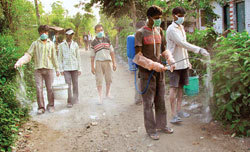Bangalore: At a time when sporadic cases of bird flu are surfacing in India, among several parts of the world, forcing countries to stockpile millions of doses of antiviral medication Tamiflu, researchers have found that this drug alone might not be sufficient in battling a bird flu pandemic.

|
| ©Reuters
|
| Health workers spray a disinfectant after culling poultry at a village in Siliguri, West Bengal. The World Health Organization has called for more collaborative research into the bird flu virus
|
In Thursday's issue of the journal
Nature, a team of researchers, led by Steven J. Gamblin from the Medical Research Council's National Institute of Medical Research in London, report a change in the H5N1 bird flu virus, which makes it resistant to Tamiflu (chemical name: oseltamivir), the main defence against a flu pandemic in humans.
The mutation in the N1 component - a virus protein called neuraminidase - was found in human cases of the disease, which suggests that
a single drug approach is likely to be ineffective in case of a flu outbreak, the researchers said. The virus is known to have infected 351 people in 14 countries since late 2003, killing 219 of them, the World Health Organization (WHO) says.
The argument that multi-drug therapy is better than single drug therapy is not new, said Shahid Jameel, senior virologist at the International Centre for Genetic Engineering and Biotechnology in New Delhi, but the latest research provides a new approach in the case of avian influenza. "It is being used in HIV but I think this paper provides the first such proposal for influenza backed by solid structural arguments," he told Mint.
The findings come at a time when resistance to oseltamivir has been reported both in the lab and from infected humans. For instance, in January, the European Centre for Disease Prevention and Control in Stockholm, Sweden, found that 660 of 2,680 influenza viruses tested had "evidence of resistance to Tamiflu". WHO is currently coordinating a global surveillance, which has found evidence of similarly resistant viruses in the US, Russia, and the Far East. "There is a real concern at the emergence of oseltamivir-resistant influenza virus," said Jameel, as currently oseltamivir and zanamivir (brand name: Relenza) are the only available drugs against H5N1. The earlier class of drugs amantadine and rimantidine are no longer effective against this virus.
The London researchers looked at the structure of N1, which is the target for both Tamiflu and Relenza. Both drugs aim to inhibit the protein, which is responsible for the release of the virus from infected human cells and the spread of the disease.
Using a technique called x-ray crystallography, the scientists looked at a mutation in the structure of N1 neuraminidase that has been observed in human cases of H5N1 and in seasonal flu. They found that when this mutation occurred, the virus became resistant to Tamiflu, while still remaining susceptible to Relenza. "Thus the drug of choice to complement Tamiflu is Relenza," Gamblin said in an email. "Although directed against the same target, they act in somewhat different ways and different mutations are responsible for conferring resistance against the two drugs."
Gamblin also insisted there is a "huge imperative" to develop further drugs that could help disable N1 protein on the virus surface. "It is likely a future pandemic will need to be tackled using a three- or four-pronged approach, much as we tackle HIV today," he said.
Countries are stocking oseltamivir after WHO advised them to prepare dealing with as much as a quarter of their population affected by the virus. India has decided to keep a minimum deterrence stock of one million doses, according to the directorate general of health services in New Delhi, although there's a provision of scaling it up to two-three million doses in case of any emergency.
Roche, a division of pharmaceuticals division of F Hoffman-La Roche Ltd, holds oseltamivir patent, but the generics are manufactured by Indian companies including Hetero Drugs Ltd, Cipla Ltd, and Ranbaxy Laboratories Ltd. The ministry of health and family welfare had rushed more than 200,000 doses to West Bengal earlier this year when the infection surfaced.
An oseltamivir-zanamivir combination would slow the development of resistance, Jameel, the New Delhi virologist, said, but
it would add to the cost of treatment. Stockpiling zanamivir could also pose problems, as its delivery is through an inhaler, whereas oseltamivir is in the tablet form, which is easier to store.
Reader Comments
to our Newsletter